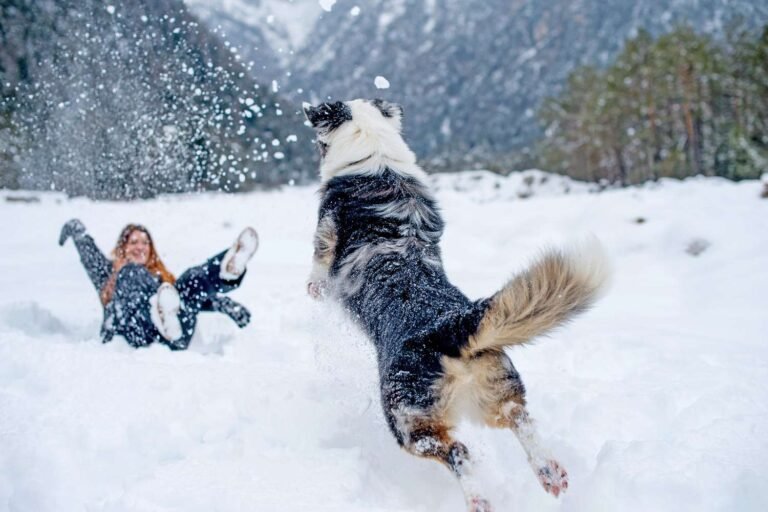Most dog owners love to include their furry friends in outdoor activities, and winter hiking offers a unique experience for you and your pup. However, ensuring a safe and enjoyable adventure requires some preparation and knowledge about the winter environment. In this post, you’ll discover practical tips for keeping your dog warm, safe, and engaged while exploring snowy trails. Whether you’re a seasoned hiker or new to the winter landscape, these insights will help you both make the most of your winter hiking experiences together.
Benefits of Winter Hiking with Your Dog
Your winter hikes can provide both you and your dog with unique experiences that enhance physical health, promote mental well-being, and strengthen your bond. The fresh, crisp air and beautiful snowy landscapes create an invigorating backdrop for adventure. Winter hiking improves your dog’s physical fitness while allowing you to connect with nature together. The snow-covered trails can also offer a refreshing change of scenery that keeps your adventures exciting and enriching. Enjoying the beauty of winter can truly make your hikes memorable.
Health Benefits
Winter hiking provides a fantastic opportunity for physical activity. Both you and your dog can enjoy the benefits of increased cardiovascular fitness, muscle strength, and joint flexibility. The cold weather often encourages you to walk at a brisker pace, keeping you warm and active while giving your dog the exercise they need. Additionally, exposure to outdoor elements can boost overall immunity and improve mental health by reducing stress and anxiety levels.
Bonding Opportunities
Benefits from winter hiking extend to your bond with your dog, as outdoor adventures foster a deep and trusting relationship. Engaging in activities together allows you to communicate non-verbally, enhancing your understanding of each other’s needs and preferences.
Another way to cultivate that bond is through shared experiences during winter hikes. When you tackle challenging trails together, both you and your dog feel a sense of accomplishment, which can strengthen your connection. The joy of exploring new environments can inspire trust and loyalty, creating memories that last a lifetime. Plus, the playful interactions in the snow will provide countless moments of joy and laughter, deepening your companionship as you launch on these memorable journeys together.
Preparing for Your Winter Hike
It’s crucial to prepare thoroughly before begining on a winter hike with your dog. Start by checking the weather forecast, as winter conditions can change rapidly. Make sure you dress in layers to stay warm, and pack extra clothing for your dog as well. Additionally, inform someone about your plans, including your destination and expected return time, and carry a first aid kit for both you and your furry companion to ensure a safer adventure.
Essential Gear for You and Your Dog
Among the various items you’ll need, make sure you have sturdy, waterproof footwear for yourself and a well-fitted, insulated jacket for your dog. Don’t forget to pack a warm blanket, food, water and a collapsible bowl, as well as a sturdy leash and a harness for better control. It’s also wise to bring a flashlight or headlamp for shorter daylight hours and a portable first aid kit for emergencies.
Assessing Trail Conditions
Assessing trail conditions is vital for ensuring a safe hiking experience. Before you head out, check online resources or local trail conditions through hiking forums or park websites. Pay attention to weather changes, snow depth, and any reports about ice or fallen trees on the trails.
Also, keep in mind that trail conditions can vary based on temperature and activity levels. Some trails may be packed down by other hikers, providing easier walking, while others may have deep snow or hidden hazards. Always trust your instincts; if a trail looks dangerous or challenging, consider choosing an alternative route to ensure both you and your dog stay safe and enjoy your adventure.
Safety Tips for Winter Hiking
Now, it’s crucial to prioritize safety while winter hiking with your dog. Keep these tips in mind:
- Choose dog-friendly trails and check for closures.
- Be aware of weather conditions and avoid harsh storms.
- Use reflective gear and harnesses for visibility.
- Stay on designated paths to protect local wildlife.
- Educate yourself on your dog’s winter limits.
Recognizing the signs of distress in your dog can ensure a safe adventure.
Avoiding Hypothermia and Frostbite
The risk of hypothermia and frostbite increases in cold weather. While dogs have fur coats, not all breeds are equipped for extreme temperatures. Keep an eye on your dog’s paws for ice build-up, and use dog booties or wax to protect their pads. Be mindful of their behavior; excessive shivering, lethargy, or reluctance to move are signs they’re getting too cold. Plan your hikes during the warmest parts of the day and limit exposure to harsh wind and icy surfaces.
Keeping Your Dog Hydrated and Energized
By ensuring your dog stays hydrated and energized, you can help maintain their stamina on winter hikes. Cold weather can mask the signs of dehydration, so offer water regularly, even if your dog seems uninterested. High-energy snacks can also boost your dog’s energy levels and keep them engaged during your adventure.
Further, consider packing a portable dog bowl and water bottle for easy access to hydration on the trail. Treats rich in protein or energy can be beneficial, especially during long hikes. Pay attention to your dog’s energy levels and give them breaks as needed. A well-hydrated and energized pup will enjoy the winter wonderland just as much as you do!
Suitable Winter Hiking Trails
After selecting the right time to hit the trails, choosing a suitable winter hiking route is crucial for both you and your dog. Look for trails that are not too technical or steep to ensure safe footing in icy conditions. Opt for paths that have been groomed or regularly used in winter to minimize hazards like dense snow or deep mud. Checking trail conditions and guidelines can help ensure an enjoyable experience for both you and your furry companion.
Local Dog-Friendly Trails
Suitable local dog-friendly trails offer you plenty of options, often featuring well-marked paths where your dog can roam freely. These trails usually allow pets on-leash and provide the chance for socialization with other dogs and hikers. You can explore outdoor maps or local hiking groups for recommendations tailored to winter conditions, ensuring a safe and fun hike for you and your four-legged friend.
National Parks and Wilderness Areas
Trails within national parks and wilderness areas provide remarkable scenery and a sense of adventure, but policies vary regarding dogs. Many parks allow dogs on designated trails, while some restrict access to preserve wildlife habitats. Always check park-specific regulations before your visit and ensure your dog is on a leash in the appropriate areas to protect the local ecosystem and enhance your hiking experience.
Parks often offer stunning landscapes and unique wildlife, making them a fantastic backdrop for your winter adventures. With trails that vary in difficulty, you can choose options that best suit your dog’s ability and stamina. Be sure to pack plenty of water and snacks, and familiarize yourself with the park’s winter conditions. Enjoy the beautiful vistas, but always prioritize safety and adhere to park rules.
Winter Hiking Etiquette
Despite the excitement of winter hiking with your dog, it’s crucial to follow proper etiquette to ensure a positive experience for everyone on the trail. Be mindful of your surroundings and share the trail amicably with other hikers and their dogs. Yield to those who are ascending, and always keep your dog on a leash to prevent any surprises or altercations. By showing respect to fellow explorers, you contribute to a friendly and enjoyable atmosphere in winter wonderlands.
Respecting Wildlife and the Environment
Around hiking trails, wildlife is often more active during winter months, so it is vital to respect their habitat. Keep your dog leashed to avoid disturbing animals, and stay on marked trails to prevent damage to sensitive areas. If you encounter wildlife, maintain a safe distance to ensure both your safety and the well-being of the animals. Following these simple practices helps protect ecosystems while allowing you both to enjoy the beauty of nature.
Keeping Other Hikers and Dogs Safe
One of the most important aspects of hiking etiquette is maintaining safety for everyone on the trail. Always control your dog’s behavior, especially around other hikers and dogs, to prevent any unwanted interactions. Alert others when approaching by calling out or using your voice to signal. If your dog is prone to excitement, consider using a muzzle as an added precaution. By exercising control and awareness, you foster a smoother experience for all trail users.
Plus, being proactive about your dog’s behavior can help ease tensions on busy trails. Keep treats handy to reward your dog for good behavior and reinforce commands to help them focus. If your dog does encounter another, use a calm voice and maintain distance while assessing the situation. Not only does this exclude potential conflicts, but it also sets an example for responsible hiking. Ultimately, ensuring the safety of your canine companion and fellow adventurers enhances the joy of your winter hikes.
Signs of Cold Stress in Dogs
Keep an eye on your dog for signs of cold stress while hiking in winter conditions. Symptoms can manifest as shivering, whining, or reluctance to move. If your dog begins to exhibit these behaviors, it is important to take action quickly to avoid serious health risks.
Recognizing Symptoms
Dogs can show various symptoms when they’re experiencing cold stress. Look for behaviors such as lifting their paws off the ground, seeking shelter, or showing signs of lethargy. If your dog is constantly shaking or curling into a ball, these could be signs that they are too cold.
When to Turn Back
Beside keeping an eye on your dog’s symptoms, knowing when to turn back is vital. If your dog starts to show clear signs of discomfort or distress, it’s time to head home. Hiking in winter can be challenging, and acknowledging your dog’s limits is an important part of a safe adventure.
Another key aspect of assessing whether to continue your hike is to monitor the weather conditions. Sudden drops in temperature or increased wind chill can exacerbate the risk of cold stress. If you see that your dog is no longer enjoying the hike, or if conditions worsen, trust your instincts and prioritize their well-being by making your way back. It’s always better to err on the side of caution when it comes to your furry friend’s health.
Summing up
Hence, winter hiking with your dog can be a safe and enjoyable adventure if you prepare adequately. Equip yourself with the right gear, monitor weather conditions, and keep your dog’s needs in mind, such as hydration and paw protection. By planning your route and maintaining awareness of potential hazards, you can create memorable outdoor experiences that strengthen your bond with your furry companion while enjoying the beauty of winter landscapes.






